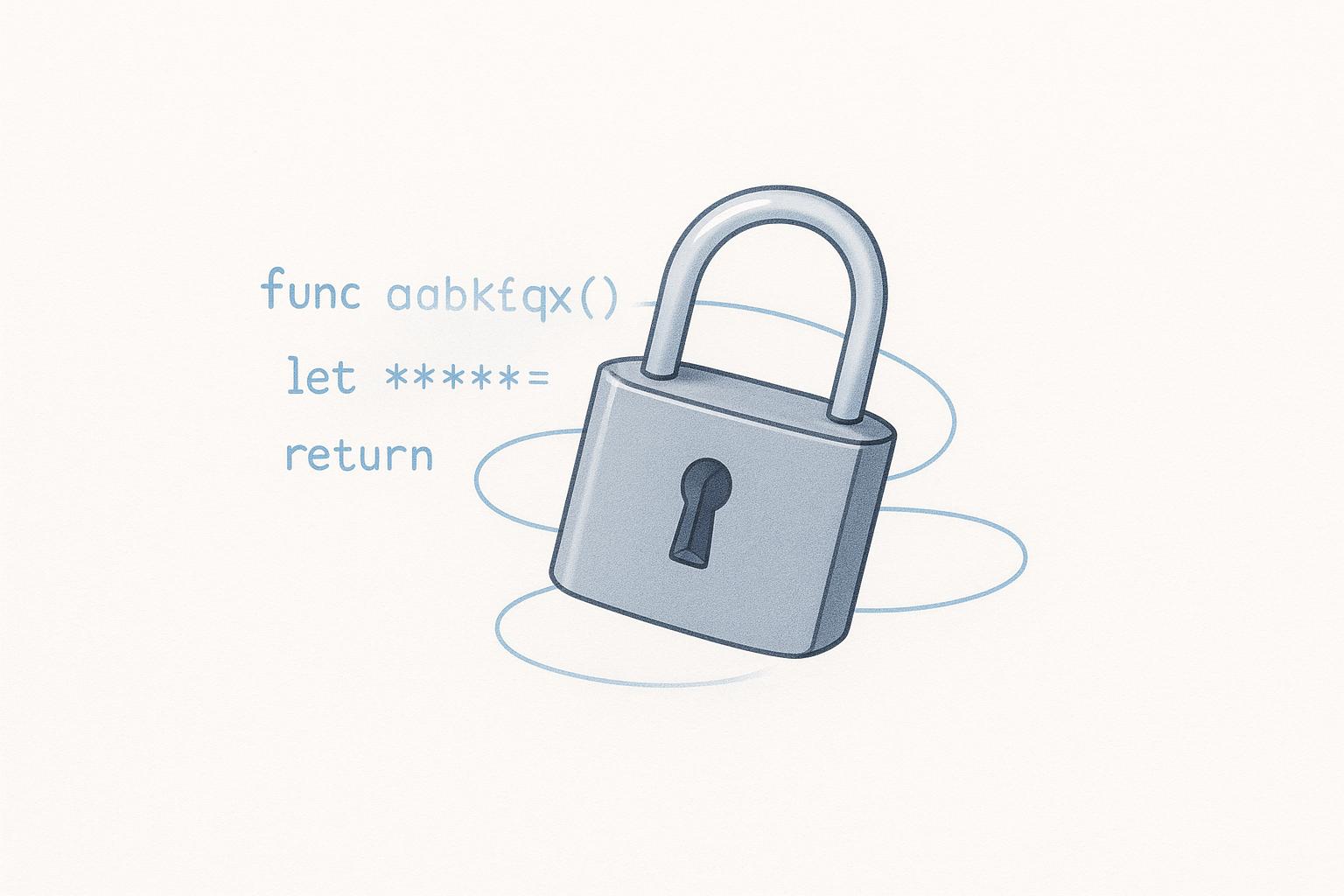Swift obfuscation makes your app's code harder to reverse-engineer while keeping its functionality intact. It's a key defense against intellectual property theft, API key exposure, and tampering. For iOS developers, obfuscation protects sensitive data, such as payment logic or encryption keys, and helps meet security standards like OWASP MASVS-RESILIENCE.
Key Takeaways:
- Why it matters: Protects your app from reverse engineering, theft, and tampering.
- Techniques: Symbol renaming, string encryption, and control flow changes.
- Tools to consider:
- SwiftShield: Focuses on renaming symbols to confuse attackers.
- Swift Confidential: Encrypts sensitive strings like API keys.
- Digital.ai Application Protection: Offers enterprise-grade security and runtime defenses.
Obfuscation works best when combined with other measures like runtime protection, certificate pinning, and anti-debugging. Choose a tool based on your app’s complexity, budget, and security needs.
#OBTS v6.0: "iObfuscate Unraveling iOS Obfuscation Techniques" - Laurie Kirk
Main Swift Obfuscation Methods
Swift obfuscation employs three main techniques to make reverse engineering more difficult while keeping the app fully functional. Let’s break them down with examples specific to Swift.
Symbol and Method Renaming
Symbol renaming replaces meaningful names in your code - like class names, method names, and variables - with random, unreadable strings. For example, a class named PaymentProcessor with a method called validateCreditCard() might turn into something like a1b2c3 with a method x9y8z7() in the obfuscated version.
This method is effective because reverse engineering tools, such as Hopper or IDA Pro, rely on descriptive names to interpret the code structure. By replacing these identifiers with meaningless strings, you make it much harder for attackers to understand your app's logic.
The renaming happens at the source code level before compilation, and mapping files are generated to help decode crash logs while keeping the code protected. Swift's strict typing system further enhances this technique. Even with renamed symbols, the code remains functional, as Swift enforces type checking. This means that everything from protocol names to extension methods and generic type parameters can be scrambled, creating an additional layer of complexity for potential attackers.
String and Literal Obfuscation
Sensitive data like API endpoints, encryption keys, database connection strings, and authentication tokens are often stored as plain text strings in mobile apps, making them easy targets for static analysis. String obfuscation addresses this issue by encrypting these strings and embedding decryption logic within the app.
For example, instead of storing an API key directly, the obfuscated version encrypts it. When the app needs the key, it decrypts it at runtime. To anyone analyzing the compiled app, these strings appear as random bytes instead of readable text.
More advanced methods might split strings into fragments or add decoy values to mislead attackers. Swift’s features, like string interpolation and multi-line string literals, can also be used creatively to further obscure data. Tools can scramble interpolated variables, break apart format strings, or obfuscate the logic used to construct dynamic strings, making it even harder for automated tools to extract useful information.
Control Flow Obfuscation
Control flow obfuscation changes the structure of your code while keeping its behavior intact. It introduces fake branches, dummy loops, and deeply nested structures to confuse both human analysts and reverse engineering tools.
One popular method is the use of opaque predicates - conditions that always produce the same result but make the code appear more complex. For instance, a simple if statement might be transformed into a tangled web of nested conditions, making the execution path harder to follow.
Another tactic is dead code injection, where blocks of code that never execute are added. These blocks can look like legitimate business logic, misleading attackers about the app’s functionality.
Swift’s syntax offers unique opportunities for control flow obfuscation. Simple constructs like switch statements can be turned into intricate nested guard clauses, while optional unwrapping can be rewritten as elaborate pattern-matching logic. Additionally, Swift’s closure syntax and higher-order functions like map, filter, and reduce can transform straightforward loops into seemingly complex functional programming constructs, further complicating analysis.
Top Swift Obfuscation Tools
Now that we've covered the basics of obfuscation methods, let's dive into some tools that bring these techniques to life in your iOS projects. Each tool offers a unique approach to safeguarding your app.
SwiftShield
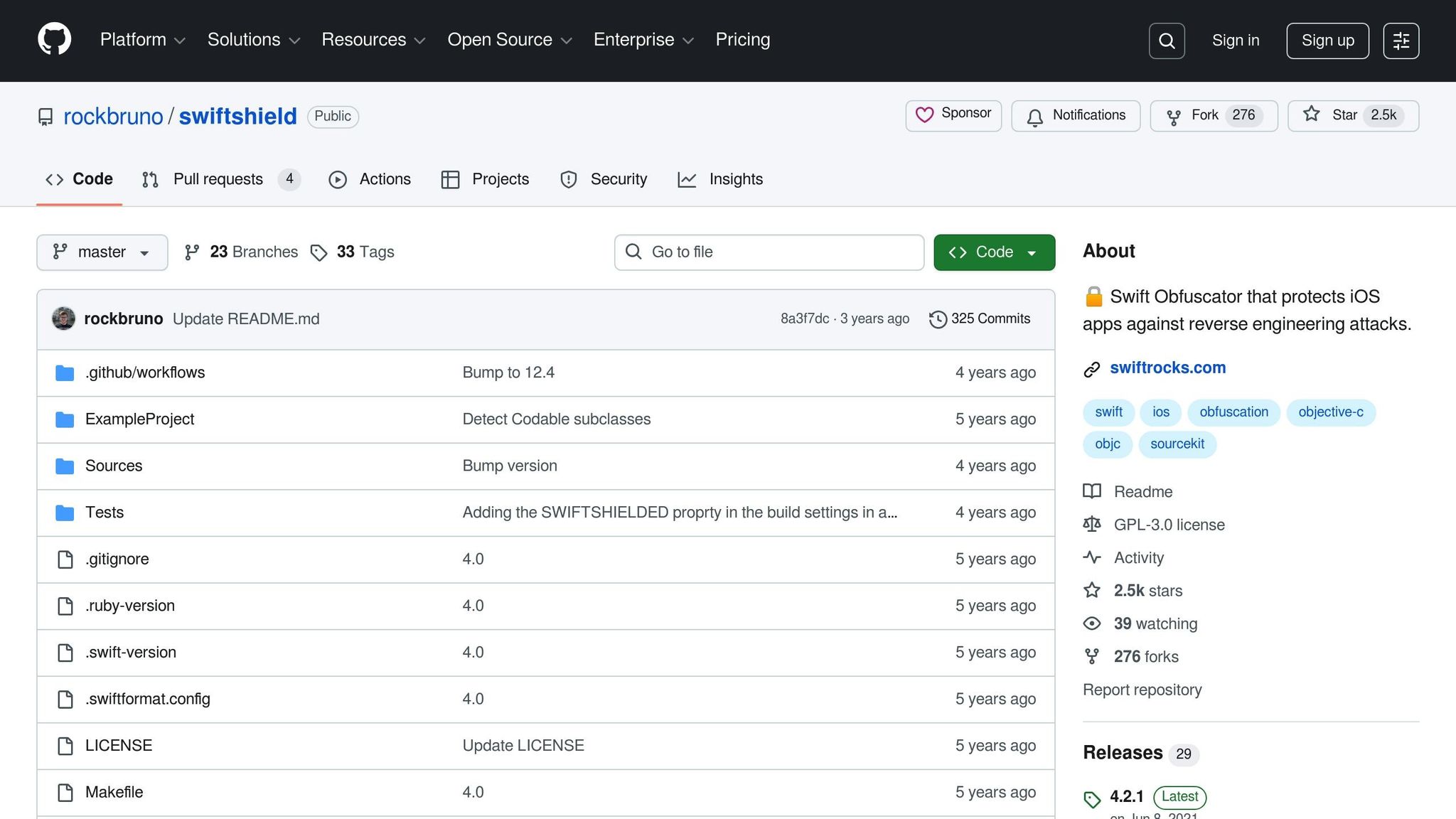
SwiftShield is a go-to tool for replacing identifiers - like class, method, and variable names - with randomized alternatives. It even works with third-party libraries. Using Apple's SourceKit, SwiftShield maps out your project before renaming symbols. What's interesting is that the obfuscation process changes every time you run it, making it tougher for reverse engineering tools like class-dump and Cycript to extract meaningful data.
After each run, SwiftShield generates a conversion map file, which is crucial for decoding crash logs using its deobfuscate subcommand. However, developers should be cautious about using SwiftShield in production apps. Compatibility issues with newer iOS versions remain a concern, with the latest update (version 4.2.1) released back on June 8, 2021. While SwiftShield excels at dynamic symbol renaming, the next tool focuses on protecting your app's literal data.
Swift Confidential
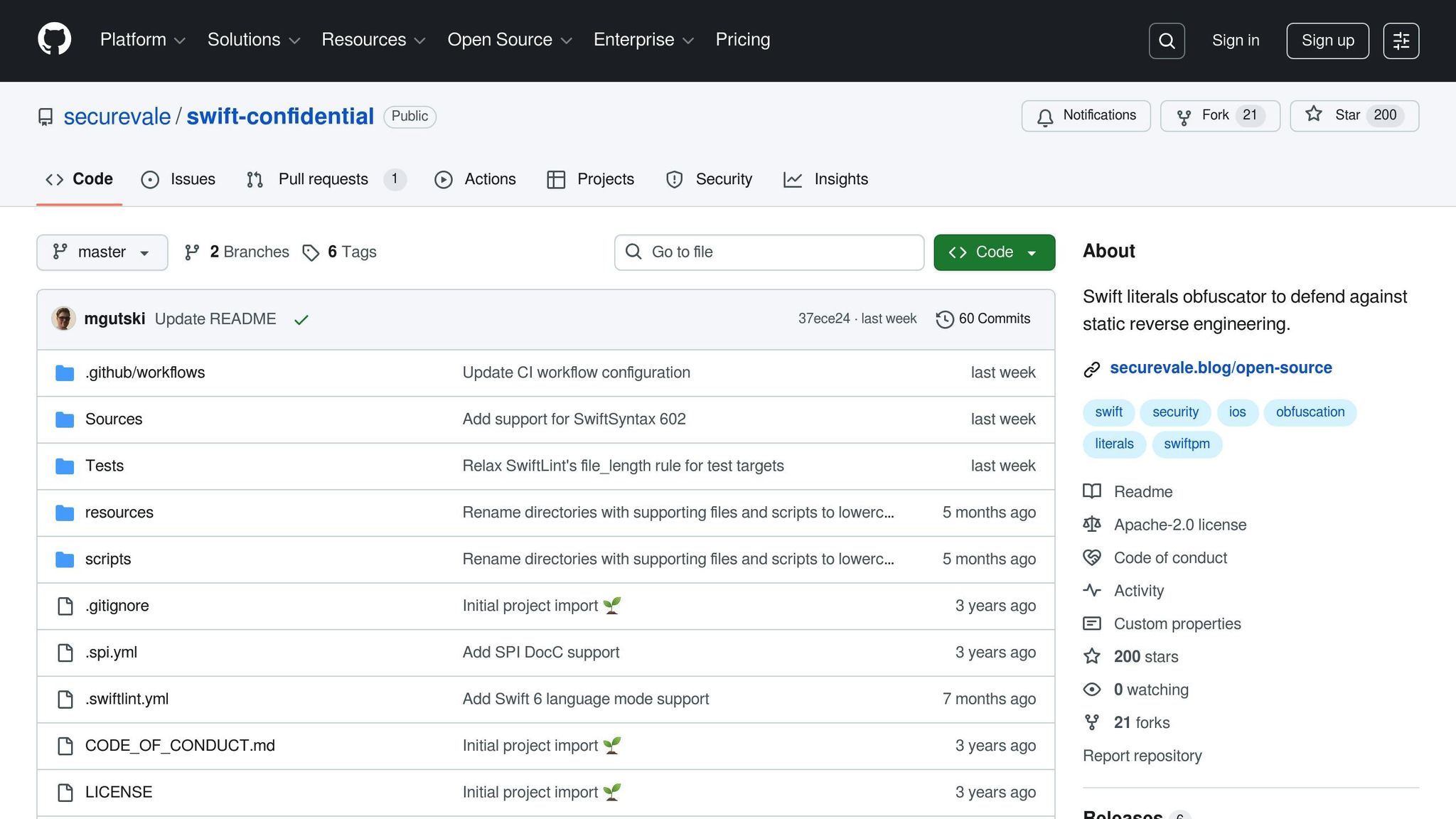
When it comes to securing sensitive data, Swift Confidential is an open-source tool worth considering. Designed to protect API keys, URLs, X.509 certificates, and other critical strings, it encrypts these elements to shield them from static reverse engineering attempts. Integration is simple - either through Swift packages or an official Xcode build tool plugin - and configuration is managed via a confidential.yml file.
What sets Swift Confidential apart is its flexible approach. It offers compression options like LZFSE, LZ4, LZMA, and zlib, paired with encryption methods such as AES-128/192/256-GCM or ChaCha20-Poly1305. This allows developers to strike a balance between security and performance. While this tool strengthens your app's defenses and aligns with OWASP MASVS-RESILIENCE guidelines, its creators emphasize that literal obfuscation works best alongside additional measures, such as Runtime Application Self-Protection (RASP). For an even broader range of security features, the next option might be a better fit.
Digital.ai Application Protection (Arxan)
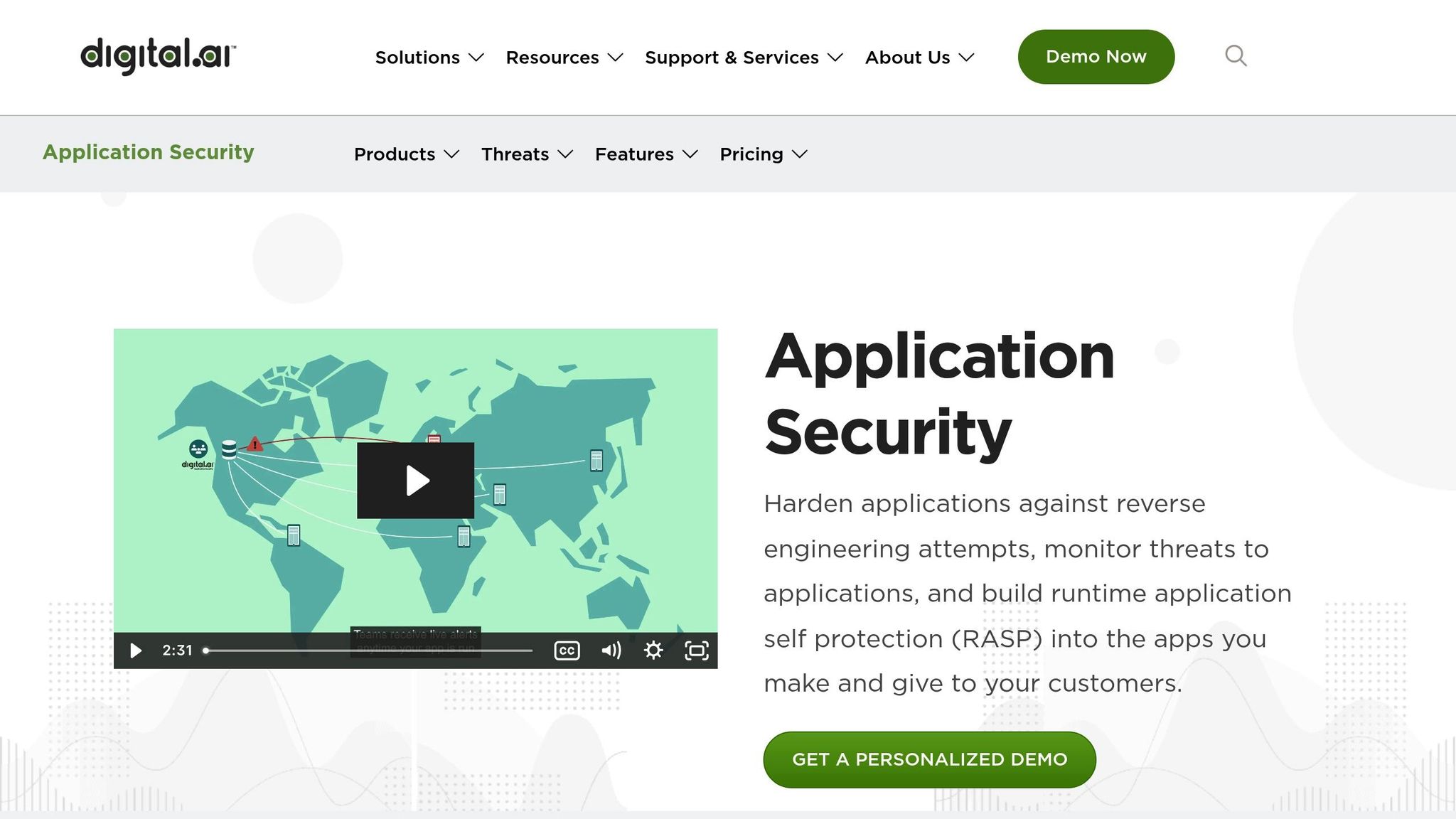
Digital.ai Application Protection takes a more comprehensive approach, going beyond basic obfuscation to deliver a full-fledged security suite. As a commercial post-processing tool, it integrates seamlessly into your CI/CD pipeline. The platform combines advanced code obfuscation and data encryption with powerful RASP capabilities. Additionally, it features Digital.ai App Aware, which provides real-time threat detection and monitoring.
This makes Digital.ai particularly appealing for industries with stringent security needs, like finance, healthcare, and enterprise applications. It addresses not only code protection but also compliance, monitoring, and incident response. Pricing for this enterprise-level solution is available upon request.
sbb-itb-8abf120
Tool Feature Comparison
After delving into Swift obfuscation techniques and the functionalities of individual tools, let’s now compare some key features to help you decide which tool fits your needs. This comparison builds on the obfuscation methods discussed earlier and provides clarity on the strengths of the available options.
The right tool will depend on factors like your security requirements, budget, and workflow. However, detailed documentation for SwiftShield and Swift Confidential is somewhat limited, which may require additional research.
Digital.ai Application Protection, on the other hand, stands out due to its comprehensive documentation and its role as part of a larger AI-powered DevSecOps platform. Unlike tools solely focused on obfuscation, it offers a complete security solution designed for enterprise clients such as AMEX, Cisco, Home Depot, and State Farm. It also integrates smoothly with CI/CD pipelines, making it a strong candidate for enterprise-level applications.
Digital.ai Application Protection Overview
| Feature | Digital.ai Application Protection |
|---|---|
| Obfuscation Focus | Part of an all-encompassing security suite; specific Swift obfuscation details are not publicly available |
| Integration | Works with CI/CD pipelines, agile workflows, ITSM, and observability tools |
| Licensing | Commercial, aimed at enterprise users |
| Target Users | Enterprise clients (e.g., AMEX, Cisco, Home Depot, State Farm) |
| Key Strengths | AI-powered platform with attack visibility and automated threat response |
From this comparison, Digital.ai Application Protection emerges as a strong option for organizations prioritizing enterprise-grade security. Its ability to integrate with broader workflows and provide automated threat responses makes it a compelling choice for large-scale applications.
For iOS developers, it may still be worth exploring SwiftShield and Swift Confidential to evaluate their specific capabilities and how they align with your project’s needs.
The next step? Understanding how to implement these tools effectively within your development pipeline.
How to Implement Obfuscation Correctly
Getting obfuscation right requires a thoughtful approach. Without proper planning and testing, you could end up with broken builds or performance hiccups. By applying the Swift techniques and tools we touched on earlier, you can secure your code while ensuring your app runs smoothly.
The trick is to understand your security needs and apply obfuscation at the right point in your development process. This way, you can strike a balance between functionality and the protection you're aiming for.
How to Choose the Right Tool
Start by assessing your risks. Pinpoint areas like sensitive data, payment processes, or proprietary algorithms that need extra protection.
Budget also plays a big role. For indie developers or small teams, open-source options like SwiftShield can provide basic protection without the added expense of licensing fees. On the other hand, enterprise-level apps that handle sensitive information might need the more advanced features of commercial tools like Digital.ai Application Protection, even if they come with a higher price tag.
Make sure the tools you choose align with your team's expertise. If you're new to security, look for solutions with solid documentation and support. Before fully committing, test the tool on a small portion of your code to check how it integrates and whether it affects performance.
Lastly, think about how obfuscation fits into your overall security plan. It's most effective when combined with other methods to create a comprehensive defense.
Using Obfuscation with Other Security Methods
Obfuscation isn’t a one-size-fits-all solution; it’s most effective as part of a multi-layered security strategy. Pairing it with other techniques strengthens your app’s defenses against a variety of threats.
- Combine obfuscation with Runtime Application Self-Protection (RASP) to detect and address threats in real time.
- Add certificate pinning to secure communications with your backend.
- Incorporate methods like binary packing, integrity checks, data encryption, and anti-debugging to create additional layers of defense.
Focus obfuscation on the most critical parts of your app. Overdoing it can hurt performance and frustrate users, so aim for a balance between security and usability.
About Zee Palm
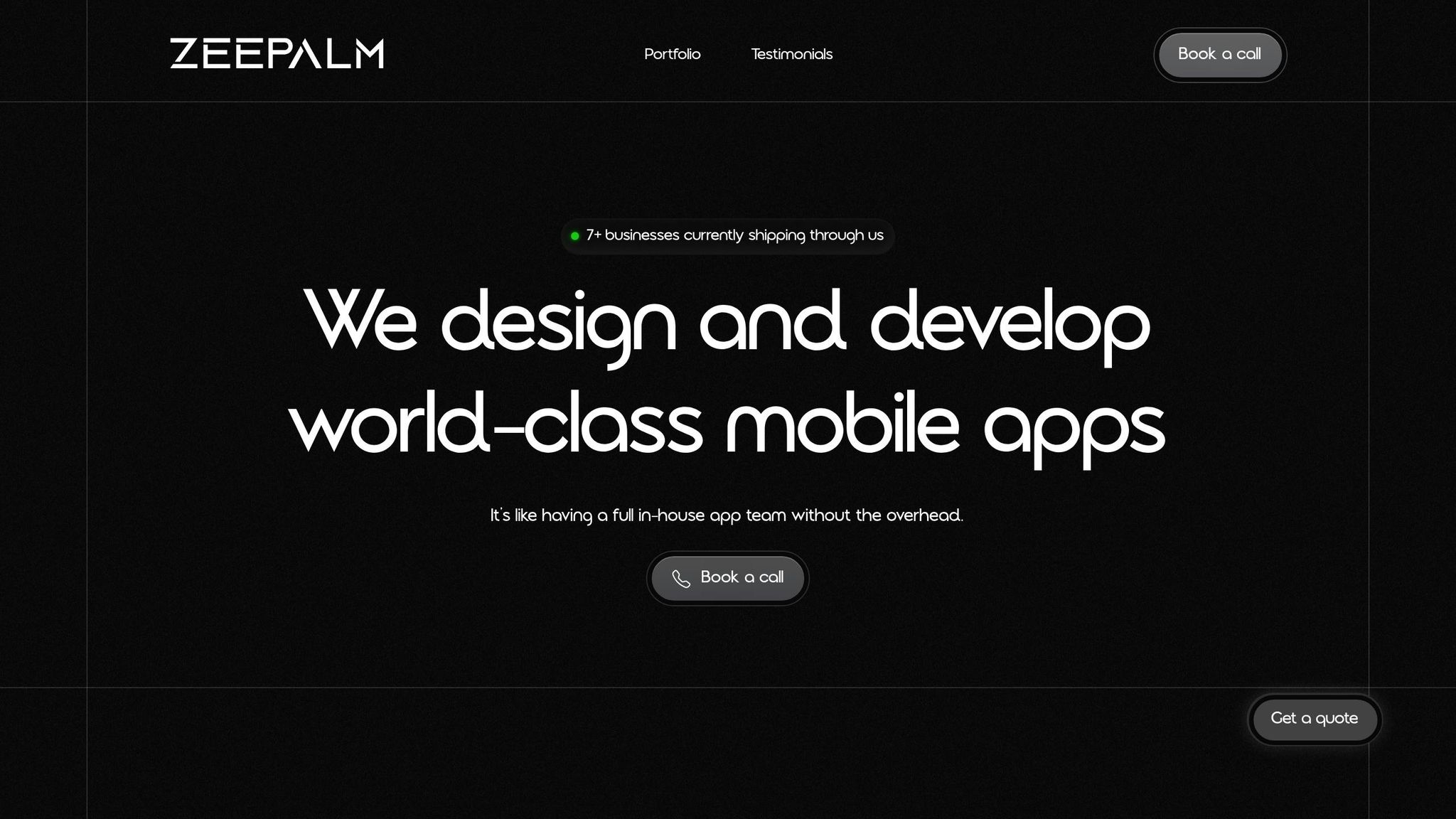
When it comes to creating secure iOS applications with robust code protection, Zee Palm brings over a decade of experience to the table. Our mission is to safeguard sensitive data and intellectual property through advanced security measures and seamless integration.
With a team of 13 dedicated professionals, we've successfully delivered more than 100 projects to over 70 satisfied clients. Our expertise lies in implementing Swift obfuscation directly into your development process - ensuring top-notch security without sacrificing performance or user experience.
Our work spans multiple industries, tailoring secure solutions to specific needs. For example:
- Healthcare apps: Designed to meet stringent HIPAA compliance standards.
- EdTech platforms: Built to protect proprietary content and intellectual assets.
- AI and SaaS applications: Secured to shield competitive algorithms and critical business logic.
Whether you're working on Web3 blockchain DApps, social media platforms, or IoT applications, we offer a range of protection options. From using SwiftShield for foundational security to employing advanced tools like Digital.ai Application Protection for more complex needs, we ensure your application is safeguarded at every level.
Our tiered security approach goes beyond code obfuscation. We implement strategies that include runtime protection, certificate pinning, and anti-debugging measures. Together, these layers form a comprehensive defense system designed to keep your application secure from every angle.
FAQs
How do SwiftShield, Swift Confidential, and Digital.ai Application Protection differ, and which one should I choose for my iOS project?
SwiftShield is an open-source tool designed to enhance the security of iOS apps by encrypting object names. It’s a solid choice for projects that need lightweight protection. On the other hand, Swift Confidential focuses on obfuscating Swift literals within your code, offering a more precise way to guard against static analysis. For those seeking a more advanced solution, Digital.ai Application Protection delivers enterprise-level security with features like obfuscation, threat monitoring, and runtime self-protection.
When selecting the right tool, think about your project’s needs. SwiftShield is ideal for straightforward, open-source projects. Swift Confidential is a better option if you require targeted code obfuscation. For large-scale or enterprise-level applications that demand extensive protection, Digital.ai Application Protection is the way to go.
What impact does Swift obfuscation have on app performance, and how can developers reduce potential drawbacks?
When obfuscating Swift code, app performance can sometimes take a hit, especially if intricate techniques are involved. This could result in slower execution or a larger app size. On the other hand, simpler approaches, like renaming variables, typically have minimal to no visible effect.
To keep potential issues in check, it's smart to focus obfuscation efforts on the most sensitive parts of the code. Afterward, thoroughly testing the app's performance and using profiling tools to pinpoint and fix any slowdowns are crucial steps. Balancing security with performance ensures you deliver an app that's both secure and efficient.
Can Swift obfuscation alone protect my iOS app, or should I use additional security measures?
Swift obfuscation is a useful technique for safeguarding your iOS app from reverse engineering. By obscuring your code, it makes it more difficult for attackers to analyze or alter it. However, it’s important to note that obfuscation alone isn’t enough to address all security risks.
To build stronger app security, obfuscation should be paired with additional measures such as code signing, encryption, secure data storage, and runtime protections. When combined, these strategies form a more layered and effective defense against vulnerabilities and unauthorized access.
